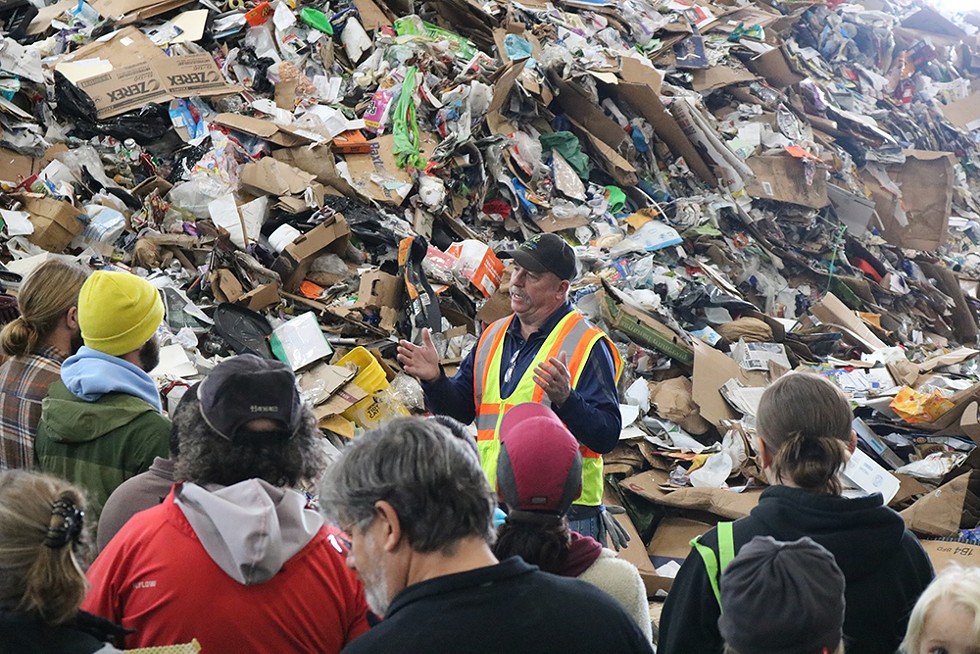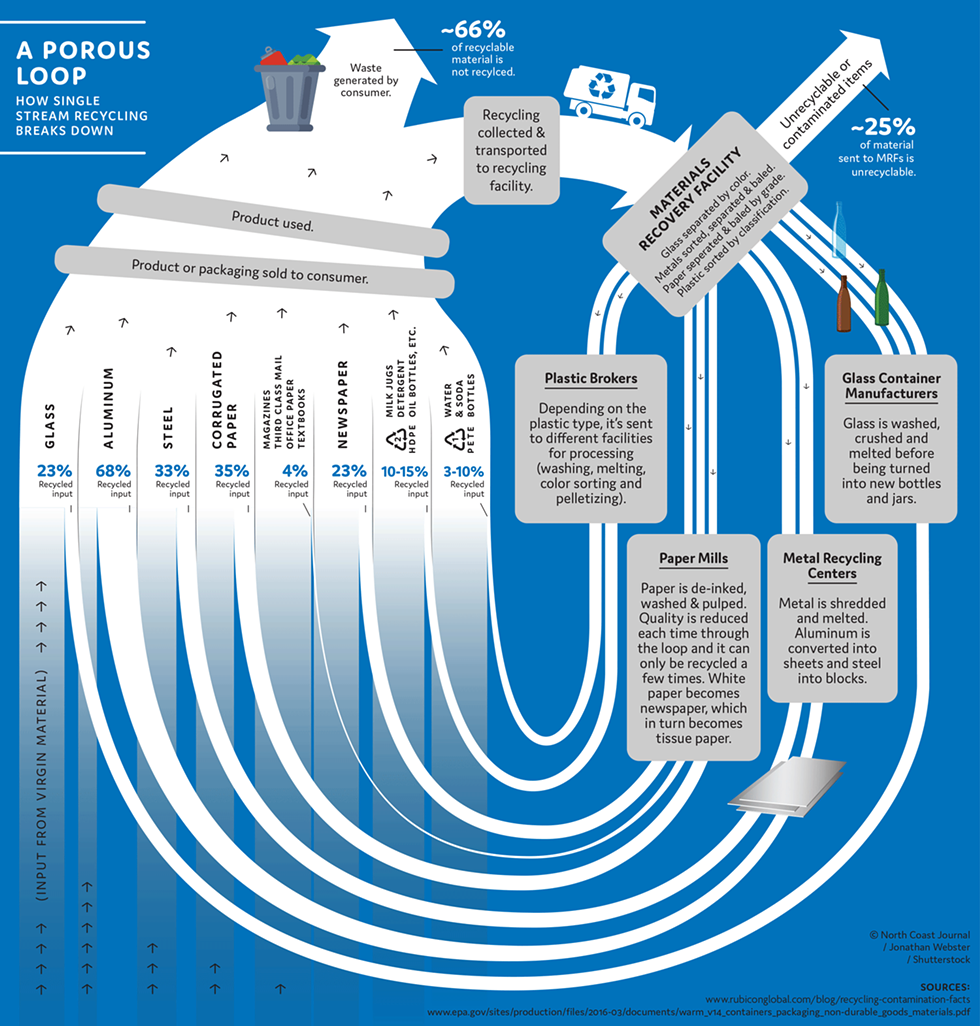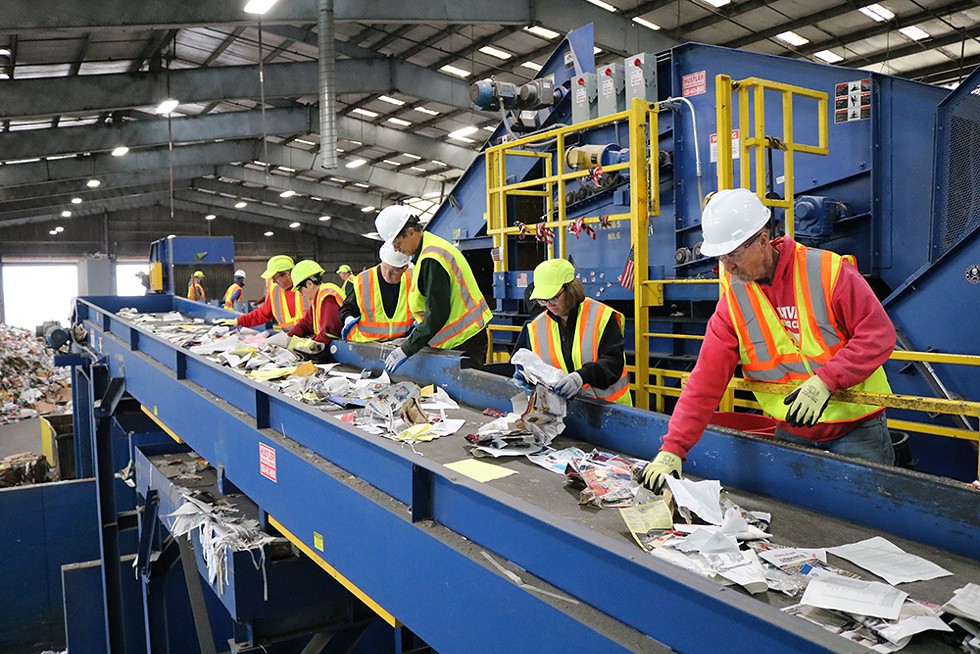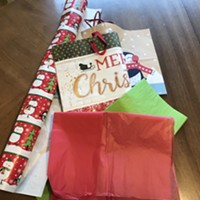Recycling's New Reality
Why recycling has grown more complicated and why you're probably doing it wrong
By Iridian Casarez [email protected][
{
"name": "Top Stories Video Pair",
"insertPoint": "15",
"component": "17087298",
"parentWrapperClass": "fdn-ads-inline-content-block",
"requiredCountToDisplay": "1"
}
]
You've gone to the grocery store, bought everything you needed for dinner — chicken and potato salad — and you're ready to cook. You peel the potatoes, chop carrots and celery, and set the scraps in the compost. You throw away the plastic mesh the potatoes came in because it's not recyclable. The mayonnaise is almost finished but there's just enough to make your potato salad.
You've dug out the last of it and now the jar is off to the blue recycling bin. You set it inside and, there, it's been recycled — another triumph in your effort to be environmentally friendly.
Not so fast.
Turns out, by not rinsing and drying the jar, you left small traces of extra mayonnaise and water. It's contaminated and no longer recyclable, and therefore off to the landfill. Worse yet, when the recycling truck comes to pick it up and compacts everything from your blue bin, the leftover mayonnaise could ooze out, potentially contaminating everything around it.
"Clean and dry, that's how we want them," Linda Wise, general manager of Recology Humboldt, said of how materials should be placed in curbside recycling bins. "There's a frequent assumption that people may think, 'It'll get cleaned later,' or, 'Food residue will melt when it's being processed,' but that's not the case."
Recyclables contaminated with food residue aside, Wise said, 25 percent of what comes through Humboldt Recology's sorting facility is just trash, like clothes and blankets, pots and pans, discarded garden hoses and unrecyclable plastic. That amount of waste in the recycling stream leads to higher prices for Recology and its customers, and makes it more difficult to keep truly recyclable materials out of the landfill.
At a Nov. 10 open house hosted by Recology Humboldt in an effort to demystify the local recycling system, frustrations bubbled over. In a crowded room, a woman clenched a list of recyclable materials in her hand, demanded to know why the information wasn't more readily available and wondered aloud where she could recycle her kids' juice boxes. (For the record, the list is on Recology's website and those juice boxes are lined with plastic and not recyclable.) Moments later, a man spoke up to lament that "dumbasses" were recycling incorrectly, driving up his rates.
It's not their — or your — imagination, recycling is arguably more complicated than it's ever been.
China, once the largest global buyer of recyclables, has implemented strict new standards on some materials and stopped purchasing others entirely, sending reverberating impacts throughout the industry. The changes have caused recycling companies to scramble to clean up their streams of recyclables to meet the needs of more selective buyers amid a surplus market that has pushed prices down considerably. And with recycling companies getting paid less for their materials on the back end, they're charging customers more on the front end while imploring them to keep trash out of their bins. Zero waste advocates, meanwhile, say the new market dynamics should just be a reminder that reducing and reusing should be consumers' primary goals.
On the heels of the Nov. 10 meeting, Wise said she gets the frustration. With the new standards — not to mention the proliferation of online shopping resulting in a dramatic increase in the amount and types of plastics — recycling is a whole new game.
Processing Recycling in Humboldt
If there's a universal truth about most waste in Humboldt County — whether trash or recycling — it's that it ends up far away.
Local trash, recyclables and green waste are collected by companies like Recology, Humboldt Sanitation, Blue Lake Garbage Co. and Tom's Trash. The vast majority of Humboldt County's trash goes to Humboldt Waste Management Authority's Hawthorne Street Transfer Station or a satellite facility approved by HWMA. Both then send the trash 200 miles away to Dry Creek landfill in Medford, Oregon.
Recyclables are a bit different and subject to global market forces. Depending on where you live and who picks up your curbside recycling, they go to one of two places before embarking on a long, sometimes global journey.
Recology Humboldt has its own recycling materials recovery facility (known as an MRF) in Samoa, so all the curbside recycling that Recology Humboldt and Recology Eel River collect (from the greater Eureka area, Fortuna and surrounding areas) goes to the Samoa station for processing, which in this case means sorting and separating. There's a misconception when it comes to the word "processing," as some people think MRFs take recyclables and actually begin breaking them down into new material but that's not how it works. MRFs only sort, separate and bail recyclables before sending them elsewhere.
Humboldt Sanitation's curbside recycling (from McKinleyville, Trinidad, Westhaven and Big Lagoon), meanwhile, is shipped unsorted to Solid Waste of Willits for processing. From Samoa or Willits, recycling is then sold to different markets — in the case of plastics or some paper, these markets are often overseas — to be processed even further.
Source-separated recycling drop-offs — those recycling centers where customers separate each recyclable item (glass, plastic and aluminum) into separate bins themselves — are different. In 1987, California enacted the California Beverage Container Recycling and Litter Reduction Act (also known as the California Bottle Bill) in an effort to divert materials from going to landfills.
When you buy a California Refund Value certified plastic or glass bottle or an aluminum can of soda from a store, you pay a deposit. Once you're done with the soda, you can take the empty, clean bottle or can to a state-certified recycling center or an obligated retailer to reclaim your 5 to 10 cents, said Lance Klug, a spokesperson for the California Department of Resources Recycling and Recovery (Cal Recycle).
Recycling centers pay people for their self-sorted bins of glass and aluminum, as well as some plastic recyclables, which are classified on a number system — 1 through 7 — based on the types of plastics they are made from. (If plastic packaging material doesn't have a number visible on it, it's probably not recyclable.)
At some source-separated recycling centers, residents also used to be able to drop off other kinds of recyclable material at no extra cost — things like office paper, magazines and cardboard. That is, until the China ban came into effect.
'National Sword'
In 2013, China, facing a growing environmental crisis, began what it dubbed "Operation Green Fence" and set rigorous inspection standards on recycling imports. Wise described this time period as "the warning." Then, in 2017, came the "National Sword" policies, which restricted and limited foreign recyclable imports from other countries. By the end of 2018, China had stopped taking all mixed plastic and mixed paper. It sent out a list of 24 recyclable materials that would be banned from entering the country, including plastics No. 3 through No. 5 — including yogurt containers and package wrappings — and unsorted mixed paper, which includes junk mail, magazines and cereal boxes.
According to Klug, China wanted to crack down on the amount of trash and contamination that was in the recycling stream in an effort to clean up its environment, which had been hampered by an abundance of plastics going into landfills or being incinerated, causing air pollution. About a quarter of California's curbside recyclables are contaminated, according to industry data, meaning the material we had been sending to China was contaminated (sullied with food or liquids) or wasn't the specific material purchased, Klug said
As part of a new set of restrictions, the country enacted a 0.5-percent contamination cap, meaning imported recyclables need to be at least 99.5 percent pure, with no more than 0.5 of any other material.
"They started cracking down on junk," Klug said. "Meaning, if you are selling them a load of plastic No. 1s, then the whole load needs to contain just that, plastic No. 1s."
Before the restrictions, the U.S. had been shipping 7 million tons of recyclable material to China every year for initial processing (separating material and sorting it), which dramatically cut down the cost for U.S. recycling companies. But all of a sudden, MRFs had to begin meticulously processing (sorting, separating and bailing) these items before sending them to the market, which is where some of the price increases come from.
Shortly after China imposed its restrictions, Southeast Asian countries stepped into the void and began collecting recycled materials, but these countries would soon be flooded with more recycling than they could accept, and quickly established their own restrictions.
In California, which once sent a third of its recyables to China, according to Cal Recycle, recycling centers and brokers are having a hard time finding other international and domestic markets. And even when they can find new ones, recyclables just aren't worth as much as they were just a handful of years ago, meaning everyone is getting paid less, Klug said, while consumers are paying more.
A Retrofit Worth the Upgrade
When China began Operation Green Fence, Recology Humboldt saw the coming trend and how it would inevitably hurt markets, so the company began looking for new buyers in other Southeast Asian countries and started selling material there much earlier than other MRFs in the U.S.
Recology Humboldt also invested $2 million in a retrofit last year that seems to be paying off, said Chuck Schager, the company's operations support specialist. The facility upgrade included a new conveyor belt that makes it easier for workers to sort material, which cut operating expenses and increased efficiency.
According to Schager and Wise, the new addition has made it possible for Recology Humboldt to continue sending material to China. The MRF recently sent 600 tons of clean mixed paper (paper No. 9) to China. In fact, it is the only MRF in California to have recently sent paper of that grade straight to China for recycling.
As Wise described it, mixed recycling is pushed onto the conveyor belt at Recology's MRF, which leads to eight initial sorting stations where line-workers take off cardboard, rigid plastic items (toys, buckets, laundry baskets and storage boxes) and garbage from the line. From there, recyclables go through a series of automated devices and screens, and head down one of three possible routes. Glass is separated, crushed and shipped in a three-color mixed bale. Paper, which is lightweight, rises to the top of the belt and is sent to a separate conveyor, which has four sorting stations to pull off contaminants (any kind of soiled paper, Post-it notes, photographs and plastic bags). Containers go onto another line, where there are four more stations that sort out aluminum and metal cans, plastic milk jugs, plastic beverage containers, pet food cans and colored rigid plastic containers. Wise said if there are obvious food or liquids in the containers, sorters let them go on to a trash compactor.
After the Nov. 10 Recology open house, Wise said line workers — which included some volunteer community members — pulled more than 200 pounds of garbage off the line in a 15-minute shift.
"If my math works, in any given day, using that figure, that portion of the line produces 6-and-a-half tons of garbage, equivalent to one garbage truck load," She said in an email to the Journal.
So, when that squished jar of mayonnaise gets to the MRF from your curbside recycling, workers have a split second to decide whether it's clean enough to send it to the proper bail or to throw it away. It is a decision that could help dictate whether an entire bail of material is accepted at a facility an ocean away.
Higher Prices, Lesser Values
In the wake of changes in China, Humboldt's recycling centers are now operating in a market where there is a very high supply but little demand. Recycling costs are increasing and, in some areas, people now must pay to recycle items they didn't have to before, like mixed paper or plastic.
Wise said that once China set these restrictions and stopped taking most recyclables — essentially closing the largest global market — just about everything went down in value. Aluminum scrap was 69 cents per pound but has since dropped to 42 cents per pound. Cardboard, which was selling for $200 per ton, dropped to $60 per ton. As Wise explained it, in a market driven by supply and demand, China's decision all at once increased supply and decreased demand.
Before China's "National Sword," there was so much demand for recyclable items that prices for some grew so high they would offset losses that recycling companies endured on others, allowing them to continue without charging customers.
"We used to be able to offset other costs of materials that weren't as profitable, but now that's not an option," Wise said, adding that now those commodities need to pay for their own processing and that's why customers are seeing new charges.
Both Humboldt Sanitation and Recology have not restricted any items from their curbside pickups. However, the Eureka Recycling Center and Humboldt Sanitation's source-separated recycling centers are now charging to accept mixed recyclable items. Tasha Eisner, general manager at Humboldt Sanitation, said it is charging for plastics Nos. 3 through 7 and mixed paper.
"The market is very small right now for plastics and paper," Eisner explained in an email to the Journal, adding that recycling centers are investing lots of resources to clean the recycling stream and that the more trash or non-recyclable items go into customers' bins, the higher the costs for everyone.
And the contamination levels in local bins are rising. When California first began curbside recycling, residents were more conscientious about their recycling habits, as they used a source-separated system for their curbside recyclables and followed the guidelines by cleaning and drying their recyclables, Klug said. But when China began buying more recyclable materials, the state started using a single-stream system in an effort to collect more recycling, which in turn stirred up some confusion among residents on what objects are actually recyclable.
'Wishful Recycling'
Having spent a lot of time on the recycling line, Schager and Wise have both seen a lot of "wishful recycling" — everything from dog beds to Amazon packaging slips — trash that people have thrown into their bins hoping it can potentially be recycled when, in fact, it's just trash.
"We see things like pots and pans, wire clothes hangers, blankets and clothes," Wise said. "These are things that people think, 'Hey, this is probably recyclable, I'm just going to put it in the bin, and they will find a place for it,' when really, it's not."
"It's become a real problem; people are still throwing away things in their curbside recycling bins that aren't actually recyclable," Schager added. "Keeping the garbage out is labor intensive and adds to the recycling cost."
Another problem, Wise said, is packaging that comes with online purchases, which changes frequently with differing qualities of plastic. Increasingly, she said, it can't be recycled.
"Every time we buy something, [the packaging] needs to be processed," Wise said referring to all the unrecyclable Amazon packaging that Recology sees come through the facility. "[Online companies] found the most convenient ways to put their products in cheap plastic packaging and it just gets too complicated."
While both HWMA and Recology are looking to expand their customers bases — which will result in their collecting more recycling, selling more commodities on the market and, ideally, lowering the costs for customers — the easiest way to increase efficiency and decrease costs would be to keep people from filling their recycling bins with 25 percent trash.
Every recycling source the Journal spoke with emphasized responsible consumer recycling. Not only do people need to ensure they are placing only clean and dry recyclables into their bins, they also need to be mindful of the products they are purchasing and the packaging they come in. The goal is to close the waste stream, which means reducing and reusing.
"Not only do we need to recycle responsibly, we also have to purchase responsibly," Schager said. "We need to look at the products we're purchasing and start thinking about buying as a consumer. Some people want to buy organic products but sometimes those products don't come in organic packaging or even recyclable packaging, which is where we need to see that change; it has to come from consumer feedback."
On the back end, Wise said there are three easy ways residents can reduce the amount of trash and contamination levels that come with curbside recycling: Don't put recyclables in bags; don't recycle wet items or ones with food particles; and reduce wishful recycling.
"If we continue to recycle using these three steps, we'd be golden," she said. "But we also need a circular economy; state bills in place to support building a recycling circular economy, to ensure that we're closing the loop of all the waste we create."
Closing the Recycling Loop
Recycling, laws — whether prohibitions or incentives — have been proven to make a marked difference.
There are 10 states in the U.S. that have passed beverage container deposit laws and, according to the Container Recycling Institute, they have a glass container recycling rate of 63 percent, while its just 24 percent for non-deposit states.
These recycling rates attest to Wise's suggestion of a circular economy. Building this economy could start with local governments and municipalities adopting certain policies to bar specific materials — for example, single-use plastic bags, water bottles and plastic straws — from coming into their waste streams.
San Francisco International Airport, for example, recently banned the sale of plastic water bottles, preventing an estimated 4 million of them from being sold annually at the airport. The ban is just one part of the airport's effort to go zero waste.
"These types of bans, whether it's single-use plastic bags or water bottles, have an impact," Maggie Gainer, co-founder of Zero Waste Humboldt, told the Journal. "I made my own keen observation: I used to count the single-use plastic bags I saw driving on the corridor from Eureka to Arcata and sometimes there would be 40 bags, and now, there are fewer and fewer. So these bans do have an effect."
The California Legislature introduced a few bills earlier this year to set vigorous recycling mandates on manufactured plastic items: Assembly Bill 792 would have required manufacturers to slowly increase the amount of recycled plastic content used in beverage containers over the next 10 years, while Assembly Bill 1080 and Senate Bill 54 (both supported by Recology) aimed to reduce the production of single-use plastic packaging and products by 75 percent by 2030.
A.B. 792, which passed in the Legislature but was later vetoed by Gov. Gavin Newsom on Oct. 12, would have required manufacturers to produce beverage containers — which currently only contain about 3 percent recycled materials — to contain 10 percent recycled plastic by 2021, then 25 percent by 2025 and finally 50 percent by 2030. Newsom cited high costs and a "burdensome process" for "the state to prove to manufacturers that their products could meet these recyclable goals" in explaining his veto.
The Legislature never voted on A.B. 1080 and S.B. 54, which lawmakers could revive in January.
Klug said that although Cal Recycle does not endorse any proposed bills, the organization understands that in order to move forward and meet the goal of closing the waste stream gap, California needs to look at materials that come into its economy, increase the content standards for recycled beverage containers and, especially, look into packaging reform.
Unlike plastic, glass and aluminum will always have a decent recycling market because both materials can easily be made into new packaging.
According to Aluminum Association spokesperson Matt Meenan, aluminum beverage cans have a closed-loop system and are often recycled back into new cans, which are made up of 70 percent recycled material — higher than any other recycled products.
"It can be as short as 60 days from when you buy a can of soda, drink it and recycle it before it's turned back into a newly packaged can of soda," Meenan told the Journal, adding that aluminum recycling rates are higher in deposit states, as is the case with glass. "While 10 of the U.S. deposit states represent about a quarter of all can consumption, they represent more than 40 percent of all cans recycled each year."
The same principles apply for glass beverage containers, according to the Glass Packaging Institute. Recycled glass containers also have a closed-loop system, as jars and bottles are recycled back into new packaging, with a recycled content of 23 percent.
Locally, some cities and agencies in Humboldt County have been prominent advocates for banning single-use plastics, most notably Humboldt State University and the city of Arcata.
In 2012, HSU banned the sale of single-use plastic water bottles campuswide, installed "hydration stations" and retrofitted campus water fountains to accommodate reusable water bottles, though the university still sells plastic bottled soda and juice.
In 2015, the Arcata City Council passed an ordinance prohibiting the use of Styrofoam in to-go food and beverage containers. More recently, in May, the council heard suggestions for a new ordinance that would, according to the staff report, ban the sale and distribution of single-use plastic beverage containers. The council also urged staff to create an amendment to the 2015 Styrofoam ordinance that would ban the use all single-use plastic from businesses.
City staff is "tentatively set to present a draft of the ordinance" to the council at a meeting next month, according to Arcata Mayor Brett Watson, who also sits on the board at Zero Waste Humboldt.
Arcata also adopted an action plan in 2017 that was written by Zero Waste Humboldt and sets the goal of becoming a zero-waste community by 2027.
Eureka, meanwhile, is also working with the nonprofit to create a Zero Waste Action Plan. According to Gainer, the city's community services department and the nonprofit are in the early stages of developing a plan and looking at how different single-use plastic bans and other zero-waste initiatives have transformed different communities.
'A Broken System'
Some believe building a circular economy is also going to take a cultural shift. Morgan McEvoy, president of the board at Zero Waste Humboldt, encourages people to start reusing plastic and reducing their own waste streams.
McEvoy tries to live in a chemical- and plastic-free home, meaning she uses natural products to clean, buys in bulk and tries her best to steer clear of plastics. But no one's perfect and if her household does buy something made from plastic, she said they will reuse it until "the legs fall off."
"We can't completely rely on recycling — it's a broken system," McEvoy said. "When people think of 'reduce, reuse, recycle,' they're solely focusing on the recycling part and not the 'reduce' or 'reuse' part. But I believe in 'Repair, reduce, reuse.'"
So when you're all done with that mayo container, at least make sure it's clean and dry before you put it into your recycling bin or — better yet — find something else to do with it. McEvoy suggests reusing it for storage. When she's finished with her jar of Veganaise, after all, she uses the containers to store spices, beans and nuts, or even as planters for herbs.
If it's a cool jar, though, she said it could also make a great vase.
Iridian Casarez is a staff writer at the Journal. She prefers she/her pronouns and can be reached at 442-1400, extension 317, or [email protected]. Follow her on Twitter @IridianCasarez.
Speaking of...
Comments (2)
Showing 1-2 of 2
more from the author
-
An Upstream Intervention
Open Door hopes state grant will help address impacts of childhood trauma
- Feb 9, 2023
-
Humboldt County Still Working to Implement Organic Waste System
- Feb 2, 2023
-
Earl Robert Bootier: 1945-2022
- Jan 25, 2023
- More »
Latest in News
Readers also liked…
-
Through Mark Larson's Lens
A local photographer's favorite images of 2022 in Humboldt
- Jan 5, 2023
-
'To Celebrate Our Sovereignty'
Yurok Tribe to host gathering honoring 'ultimate river warrior' on the anniversary of the U.S. Supreme Court ruling that changed everything
- Jun 8, 2023



































